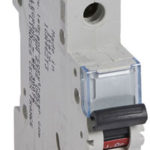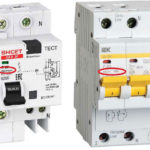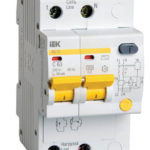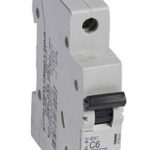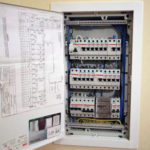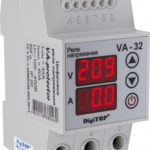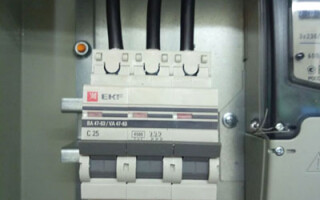When you arrange the electrical network in a private home or apartment, it is important to choose the right circuit breakers for each line based on the capacity of electrical appliances to be connected. All of these protective devices are usually mounted in the electrical panel and provide overload or short-circuit protection. But if all these devices protect the lines to the power consumer, then you need a device that protects a group of circuit breakers in the panel. Such a device is the so-called "input" circuit breaker.
Contents
Appointment of automatic circuit breaker
To understand what for all the same need a "ground fault circuit breaker", let's briefly understand what a circuit breaker in the general case and what it is needed for.
Automatic circuit breaker - A contact switching device capable of disconnecting electrical networks in the event of an abnormal situation (overload or short-circuit).
The automatic gas circuit breaker in its appearance, operation mechanism and design does not differ from the usual protective device controlling any electric line. The only and most important difference is its rating, which for a certain (calculated) order of magnitude higher, taking into account selectivitythan any line circuit breaker in the switchboard.
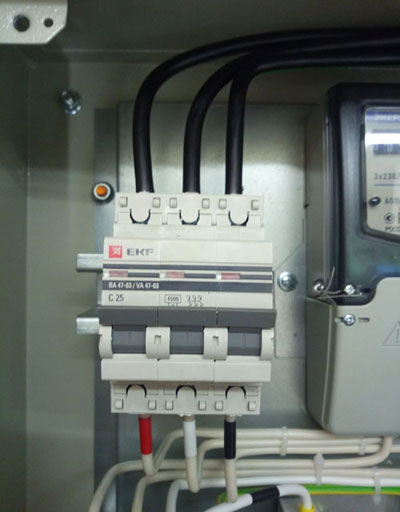
It is essential to install the automatic circuit breaker at the entry of electric cable into the apartment or private house. It protects the whole electrical network of the dwelling against overloading, but also serves to cut off power to the whole object (for example for carrying out electrical work or other repairs). It also ensures the correct operation of the supply electrical cable and does not allow to exceed the load set for the room.
Basic selection criteria
In order to choose the correct input circuit breaker (BA), it is necessary to know what characteristics you should pay attention to when buying.
Rated current
This is the most important characteristic when choosing a ground fault circuit breaker. This property of the device indicates the maximum current, above which the power supply will be disconnected, for a certain time.
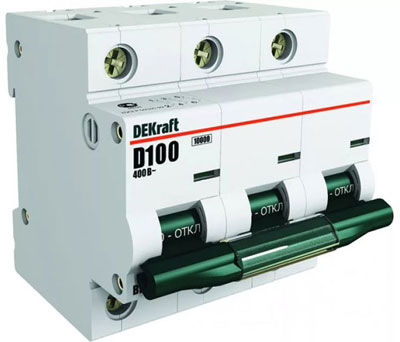
Note! Circuit breakers serve to protect the cable from overheating and the rating must be chosen taking the cross-sectional area of the conductors into account!
Regardless of whether the circuit breaker is an input circuit breaker or provides protection for a particular line (wires), its calculation is based on the maximum power of electricity consumers. The rating of the input device is selected by calculating the power (or current) of all consumers at the same time, for greater safety reducing the obtained number by 10-15%, rounding to a lower value.
Number of poles
Automatic machines with a different number of poles exist. Single-pole breakers are used to protect individual lines. Two, three or four-pole circuit breakers usually perform the function of an input circuit breaker.
An important rule to help you choose the number of poles is that two-pole circuit breakers are used for single-phase networks and three- or four-pole circuit breakers for three-phase networks.
Two-pole circuit breakers are made with a lever and tripping mechanism common to both poles. This means that in the event of an emergency, two poles are disconnected at the same time (normally a phase is connected to one terminal and a zero is connected to the other). These devices are often used in single-phase networks in apartment buildings.
Three-pole (or four-pole) circuit breaker is used when introducing the electrical cable in private homes in three-phase networks, as well as in industrial buildings and even in some apartments. A phase (and a zero if it is a four-pole). It also, like a two-pole, has a common lever for all poles and if there is an overload it cuts off the power to all phases.
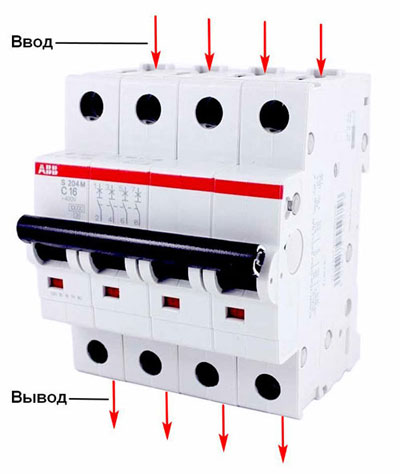
Time-current characteristic
It characterizes the instantaneous tripping current and is usually identified on the device with the Latin letters B, C or D. The time-current characteristic determines the sensitivity of the protective device to inrush currents of appliances and equipment. For a main circuit breaker, this property is important because it affects the tripping of downstream groups of circuit breakers.
Most often the following types of circuit breakers are used according to the time-current characteristic:
- B - when the current is 3 to 5 times higher than the rated current, the electromagnetic release will trip and the unit will shut down immediately;
- C - electromagnetic release will trip if the current exceeds 5-10 times the rated current;
- D - it will trip when the current exceeds 10-20 times the rated current.
For an automatic breaker in the living room devices are used with time-current characteristic of type C, since most devices in the home environment do not have high inrush currents and will not have a negative impact on the electrical network of the apartment or house.
The tripping characteristics of each device are specified in the passport and instructions of the manufacturer of the circuit breaker.
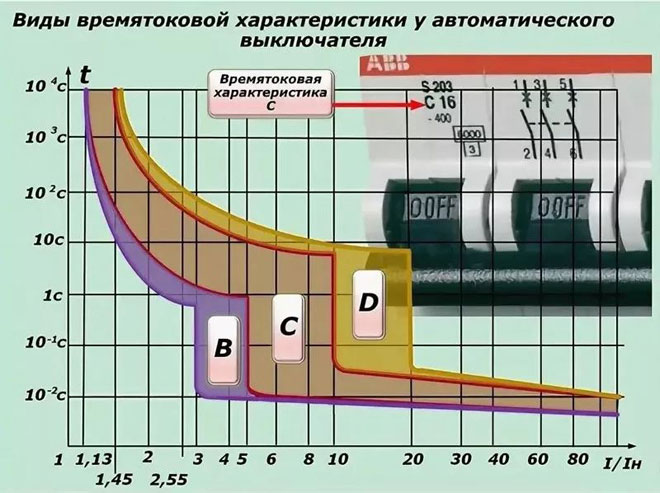
Mounting Method
All circuit breakers have a standard mounting and are placed on the din-rail in the switchboard. The same rule applies to input circuit breakers. The exception are special devices for industrial purposes, which can be mounted without a din-rail on special mountings.
Breaker brand
When choosing a main circuit breaker, as well as in the case with the choice of any electrical devices, it is important to focus on a well-known manufacturer that has earned recognition. Such manufacturers give a quality guarantee on their devices and make reliable, durable and safe circuit breakers. The most popular at the moment include circuit breakers from the following manufacturers:
- ABB - Swedish-Swiss brand, which produces high-quality electrical products. Circuit breakers of this firm are compact, high-quality assembled devices that provide reliable protection of electrical networks from emergencies.
- Schneider Electric - is a French company whose products are widely represented in Russia. The circuit breakers of this company are affordable, reliable and durable, immediately actuate when the rated current is exceeded.
- Legrand - is also a French company with a worldwide reputation. It often appears in ratings of electrical products and is deservedly one of the best manufacturers of circuit breakers in Europe.
- IEK - The IEK is a Russian company, whose circuit breakers have a favorable price and are devices of acceptable quality. Among the domestic devices of this firm, automatic circuit breakers are the most popular due to their availability and are used in many apartments and private homes.
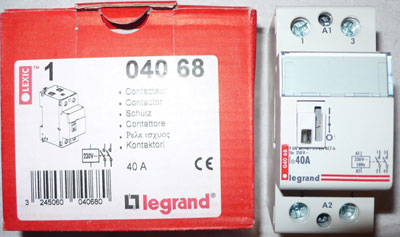
Calculation of the rating of the main circuit breaker
Operation of devices and the safety of the electrical network in a house or apartment depends directly on the correct choice of circuit breakers, including the input device. To calculate the rating of the input circuit breaker, you need to have some electrical knowledge.
For a private house 380 V 15 kW
To calculate the rating of automatic circuit breaker for a private home, you need to consider the following values: the voltage in the network (U), power (P) of all electrical appliances that will operate in the network, the correction factor that takes into account the simultaneous switching of appliances and the quality of electrical wiring.
Calculation example:
Let's assume that the sum of powers of all appliances in a house is 15 kW (This is the same power that is normally supplied to private residential buildings in Russia) at 380 V. To calculate the current, we use Ohm's Law for an electric circuit:
I=P/U;
I=15000/380 = 39.47 A.
Introduce a correction factor. Since all electrical appliances in the house will not be switched on simultaneously and considering the old wiring, we take the value of the correction factor equal to 0,85.
In=39.47x0.85 = 33.55.
The closest rated circuit breakers are 32A and 40A. We choose the rating in the smallest direction. And we obtain that for our private house requires a three-pole or four-pole input breaker for 32 А.
For the apartment of 220 V.
For apartments with 220 V automatic circuit breaker calculation is similar to the choice of automatic circuit breaker for a private residence. The only difference is that the power and voltage of the network will change.
Example of calculation:
Let's assume that the sum of the power will be 10 kW, the correction factor will be taken 0.85, and the voltage, as we already know, is 220 V. Then:
In=10000/220*0.85= 45.45x0.85 = 38.63.
Proceeding from the obtained value and rounding the nominal value to the smallest one, we choose the circuit breaker 32 А.
Circuit breaker connection diagram
In principle, the installation and connection of the input circuit breaker is almost no different from the installation of an ordinary circuit breaker. The circuit breaker is mounted on pinrail and connected up to the counter (with obligatory sealing) or after. From there, the rest of the circuit breakers are mounted to protect each line of the living space.
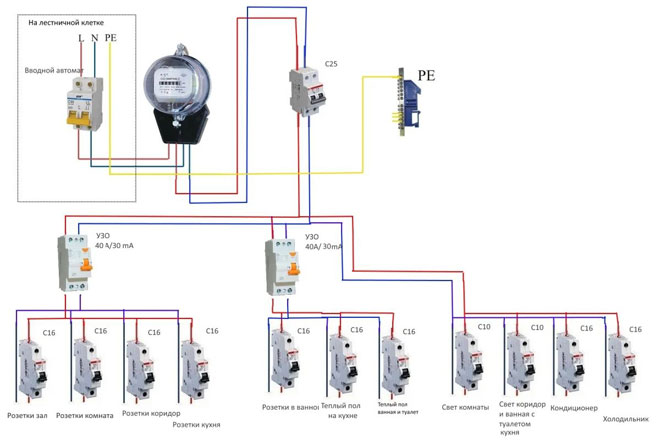
Unacceptable mistakes when buying
The most common mistakes when choosing and buying automatic circuit breakers are ignorance of the principles of its work and the choice of rating of automatic circuit breaker below or above the required value. If you choose a lower rated circuit breaker, it is possible false triggering of protection and disconnection of the whole apartment because of one device. If you choose a higher rating than the required value, it may trip after the wire insulation or devices inside the electrical box overheat and begin to melt or burn.
There are also "professionals" who connect two single-pole circuit breakers instead of two-pole, not knowing that it violates electrical safety requirements and PUE prohibits such connection.
If there is any doubt in the choice and installation of such a device, it is worth contacting a professional electrician and be safe for the correct choice and safe installation.
Related articles:
